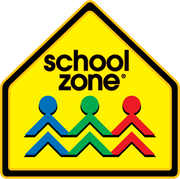November brings celebration of veterans' service to country, tables laden with turkey and mashed potatoes, and the National PTA's Healthy Lifestyles Month. Though November is winding down, unlike mincemeat pie, the key takeaways should be on the table all the time.
Get kids moving, moving, moving

A post about the event on the National PTA website says, "Back in the day, it wasn't hard to lure children outdoors to play. But with cellphones, social media, video games and the like, more children are turning into couch potatoes — and at earlier ages." It continues: "This year's theme is 'Get Off Your Apps,'" adding, "Let's encourage children to turn off their devices and connect with family and friends through constructive play, family exercise, and physical education programs at school and at home."
However, there are apps that do encourage movement and constructive play, often combining it with other skills. For example, one activity on Anywhere Teacher, School Zone's online learning program for kids ages 2-8, is "Get Up and Move Action Words" interactive flash cards. One side names a critter and describes how it moves, and the flipside asks kids to do the same, i.e, "flutter like a butterfly," "crawl like a crab, etc." Besides moving around, kids expand their vocabulary and stretch their imagination.

Kids will look forward to doing what they like doing, and just like adults, that's going to vary from one child to the next. The Office of Disease Prevention and Health Promotion (ODPHP) has a fun site called Move Your Way®, with a page titled "Help Your Kids Get More Physical Activity," that not only includes ideas for getting kids moving but has sliding gages for measuring how much activity kids should get in the morning, during the day, and after school. In total, the site says, "Kids need 60 minutes of activity every day." Here are some of their suggestions:
- Walk the dog
- Dance around the living room
- Do morning stretches or yoga
- Sign up for after-school classes like swimming or karate
- Play team sports
- Ride bikes and play outdoors with friends
- Play catch or kickball
- Start a family dance party

Healthy Children, an organization that says only 1 in 4 kids are getting 60 minutes of daily activity, published "11 Ways to Encourage Your Child to Be Physically Active." One primary way is to get the whole family moving. The article says, "Studies have found that lifestyles learned in childhood are much likelier to stay with a person into adulthood. If sports and physical activities are a family priority, they will provide children and parents with a strong foundation for a lifetime of health."
They also suggest and offer tips for creating a Family Media Use Plan to "help balance online and off-line activities." Two of the tips include setting screen-free zones such as the dinner table and screen-free times "such as during homework or before bed."
Make healthy choices habit-forming
Though the theme of this year's PTA Healthy Lifestyles event focuses on screen time, every year it more broadly "promotes healthy nutrition and a balanced lifestyle." John Dryden, an English poet who died in 1700, made an oft-quoted, wise observation that has withstood the test of time: "We first make our habits, and then our habits make us."
It's fairly intuitive that childhood, as Healthy Children noted, is the ideal time to establish good habits. Kids tend to be really receptive to learning and forming routines, which makes it easier to instill positive behaviors that can yes, last a lifetime.
Most of us who ever tried to break a bad habit or establish a good one, would attest to the challenge. Just think "New Year's resolutions." Though largely pertaining to adults, multiple websites, including ActiveIron®, cite the 21/90 rule stating "that it takes 21 days to make a habit and 90 days to make it a permanent lifestyle change." Many sources suggest that breaking a bad habit, though it varies, can take from 18 to 254 days.
Anywhere Teacher includes activities for helping kids form healthy habits for emotional and physical well-being. Kids learn how to appropriately express feelings by watching others, and the ability to recognize and identify feelings is important for emotional health and effective social interaction. In a video titled "Introducing Basic Emotions," little ones watch animated facial expressions associated with 12 common emotions and also see each feeling name and hear it pronounced.
And Emotions Flash Cards help kids learn to identify their feelings, manage them in healthy ways, and recognize others' feelings, essential skills that take lots of practice. Soon kids will be able to say, "I can recognize basic emotions," "I can name my own emotions," "I can control my emotions," and "I can be aware of other people's emotions."
Soon Anywhere Teacher will also be releasing a book titled Healthy Habits We Choose, teaching kids about healthy eating and sleeping habits, the importance of hydration, and how to reduce the spread of germs.
Keep the healthy momentum rolling during the holidays
Though November is waning, the Big Holiday Season is cranking up. In the scurry and disrupted routines, it's easy to let healthy habits slip away. To help control the slide, Children's Hospital Colorado posted "Staying Healthy During Holidays: Physically, Mentally and Emotionally." It includes great ideas for reducing grown-up stress and holding to basics like adequate hydration.

Similarly, the YMCA of Brandywine (PA) posted "6 Tips for a Healthy Holiday Season." It includes CDC sleep recommendations for kids of various ages, hydration reminders, and healthy holiday eating tips. For exercise, a few of several they suggest are:
- "Snow-fun activities like snowshoeing, skiing (downhill and cross country), or building a snowman
- Ice skating at a local rink
- Building an indoor obstacle course
- Checking out the local pool or aquatic center for a swim
- Taking a winter hike"
Show kids that "good for you" can really be good. And lots of fun, too!












